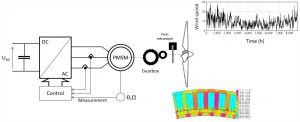Background
In the field of marine energies, the sizing of the electrical generator that ensures the electromechanical energy conversion is a real challenge. Indeed, it must integrate at the same time operating constraints (a highly fluctuating production), power constraints (interaction with the power converter and the grid), mass, size and technological constraints (choice and cost of materials).
Scientific advances and innovation
The goal of the OCEOS project is therefore to develop a design optimization that consider torque and speed profiles for the generator associated to its power converter and eventually a gearbox, each component of the power chain having its own constraints.
The models and methodology developed, will be applied to the specific case of wind energy (which may be floating or fixed). The topology of the electrical generator, its materials and its control strategy will be established with the following main objectives:
- maximization of energy efficiency
- minimization of costs (over the complete life of the system).
Such a study, to be relevant, requires the use of real sizing models describing accurately the behavior of physical parameters (magnetic fields, temperatures, strength…), when existing studies are limited to the only power flows via the consideration of constant conversion efficiencies regardless of operating conditions.
The result will therefore be based on multi-physical modeling combining electromagnetism, electricity, power electronics, mechanical and thermal.

Expected technical and economic impact
The goal is to continue the increase in power of future generators, over 10 MW, without increasing volume and mass. A specific attention will therefore be paid to thermal modeling which, taking into account the high levels of generated power targeted, will be fluid-cooling.
Key project milestones
- September 2019 - Kick-Off of the project
- March 2021 - Closure of the project
Demonstrator
Based on the proposed concept, IREENA and Université de Nantes will design a reduced scale demonstrator for validation as part of a follow-up to the OCEOS project.
Publications and papers published
Oral communications
- Linh Dang, Serigne Ousmane Samb, Nicolas Bernard, Design optimization of a direct-drive PMSG considering the torque-speed profile-Application for Offshore wind energy, International Conference on Electrical Machines (ICEM), 2020
- Nicolas Bernard, Linh Dang, Ousmane Samb, Ryad Sadou, Dimensionnement sur cycle des génératrices synchrones à aimants fort couple-basse vitesse, Symposium de Génie Electrique (SGE 2020), 30 Juin – 2 Juillet 2020/post-poned in July 2021, Nantes, France






